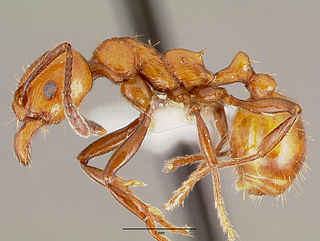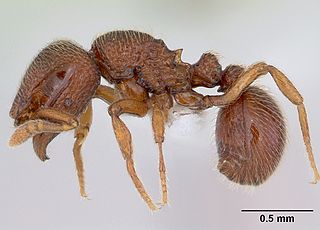
Fulakora saundersi, commonly known as "The New Zealand Michelin ant", is a species of ant within the family Formicidae in the genus Fulakora, found throughout New Zealand.

Huberia striata is a species of ant in the genus Huberia, endemic to New Zealand.
Formicoxenus sibiricus is a species of ant in the genus Formicoxenus. It is endemic to Russia.

Hemiphlebia mirabilis, commonly known as the ancient greenling, is a species of damselfly, the only living species of the genus Hemiphlebia and the family Hemiphlebiidae. It is very small with a long, metallic-green body and clear wings. It is endemic to south-eastern Australia. Its natural swamp habitat is threatened by habitat loss. The oldest representatives of the family date to the Late Jurassic.

Eutetramorium is a small genus of ants within the subfamily Myrmicinae. To date it contains three species found in Madagascar and Comoros.

Dicroaspis is an African genus of ants in the subfamily Myrmicinae.

Huberia is a genus of ants in the subfamily Myrmicinae. The genus contains two species endemic to New Zealand.

Notostigma carazzii is a species of ant belonging to the genus Notostigma. The ant was first described by Carlo Emery in 1895. The species is endemic to Australia. Specimens are mainly found in the state of Queensland, and foraging workers are solitarily and nocturnal.

Onychomyrmex hedleyi is a species of ant in the genus Onychomyrmex, which is endemic to Australia. Described by Emery in 1895, the ant is known to have similar behaviours to Army ants.
Heteroponera imbellis is a species of ant, in the genus Heteroponera. Endemic to Australia, it was described by Carlo Emery in 1895.

Leptomyrmex tibialis is a species of ant in the genus Leptomyrmex. First described by Carlo Emery in 1895 as Leptomyrmex nigriventris tibialis, the species is endemic to Australia, and found in both New South Wales and Queensland. The arguments for synonymy were made by Lucky and Ward, and the decision was accepted by the Australian Faunal Directory.
Azteca christopherseni is a species of ant in the genus Azteca. Described by Forel in 1912, the species is endemic to Panama.
Pleorotus was a monotypic genus of Seychelloise huntsman spiders containing the single species, Pleorotus braueri. It was first described by Eugène Louis Simon in 1898, and was endemic to the Seychelles. The description was based on a single male collected on Mahe Island in 1894, but none have been found in later collections, and it has been declared extinct.
Ommatauxesis is a monotypic genus of Australian araneomorph spiders in the family Toxopidae containing the single species, Ommatauxesis macrops. It was first described by Eugène Simon in 1903, and has only been found in Australia. Originally placed with the Cybaeidae, it was moved to the intertidal spiders in 1967, and to the Toxopidae in 2017.
Metriopelma is a monotypic genus of Mexican tarantulas currently containing the single species, Metriopelma breyeri. It was first described by Léon Becker (1826–1909) in 1878, and originally found by Eugenio Dugès (1834–1895). This tarantula was named after Albert Breyer (1812–1876), a fellow entomologist. It is native to Mexico in the state of Guanajuato.

Synlestes is a genus of damselflies in the family Synlestidae. Species of Synlestes are very large damselflies, metallic green to dark bronze or black in colour with white, yellow or orange markings. Unlike many other damselflies, they spread their wings when resting. They are endemic to eastern Australia where they inhabit streams.

Lasius grandis is a species of ant from the genus Lasius. The species was originally described by Forel in 1909. It occurs in the Mediterranean region of Europe and North Africa, more precisely in the Portuguese and Spanish mainland, in Andorra, the Azores, the Balearic Islands and Canary Islands.
Paraparatrechina neela is a species of small ants in the subfamily Formicinae and the genus Paraparatrechina. Discovered in 2024, it is only known from India. It is a small ant, having a total body length of less than 2 mm (0.079 in). Its body is predominantly metallic blue in color, except for the antennae, mandibles, eyes, and legs. Consequently, it is known as the blue ant.










